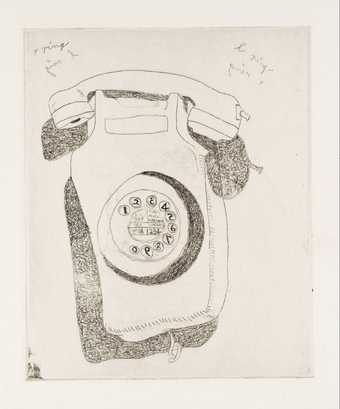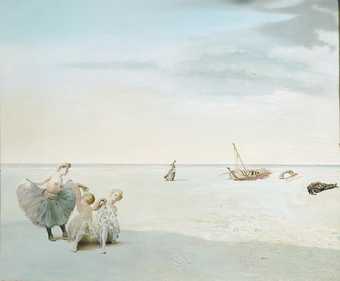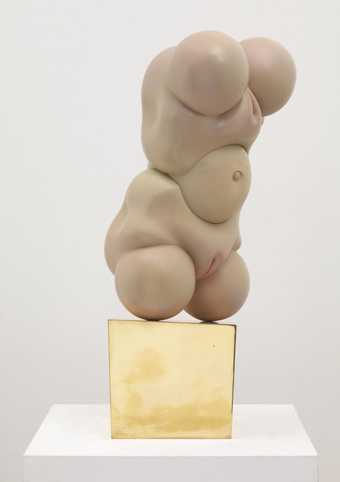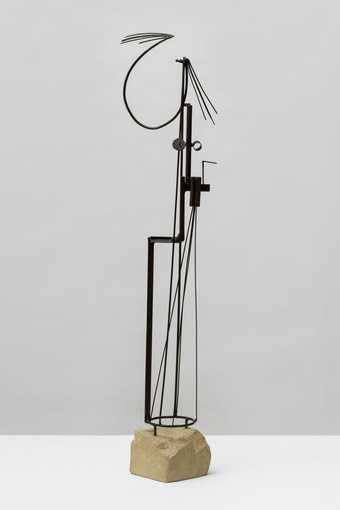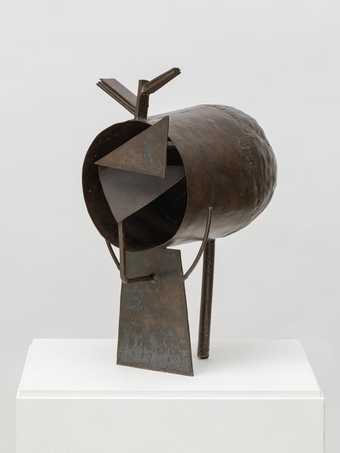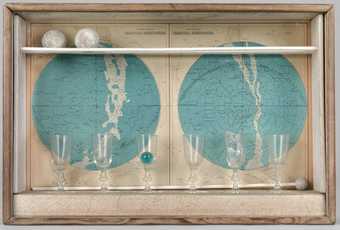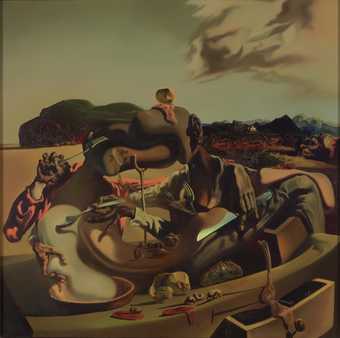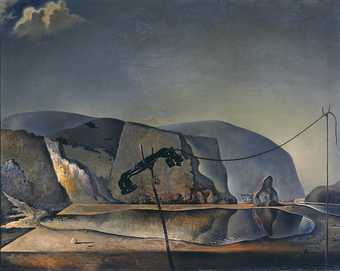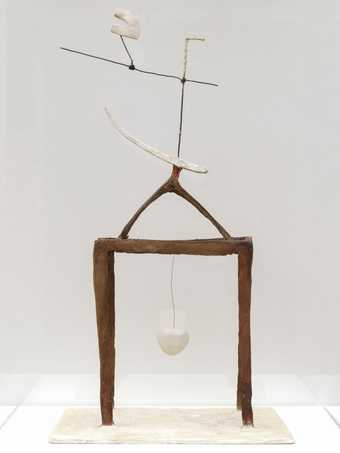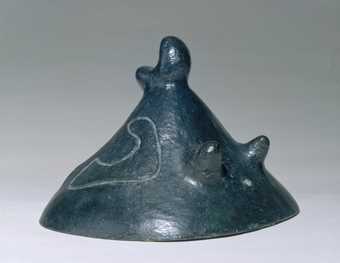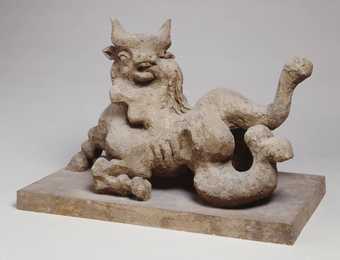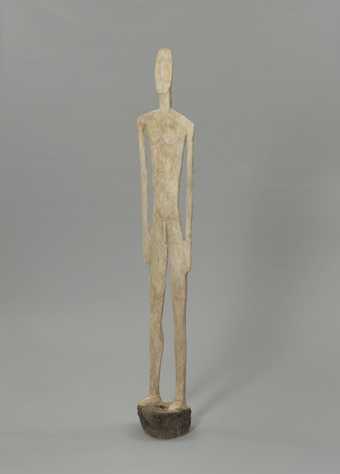
Not on display
- Artist
- Salvador Dalí 1904–1989
- Original title
- Téléphone - Homard
- Medium
- Steel, plaster, rubber, resin and paper
- Dimensions
- Object: 178 × 330 × 178 mm
- Collection
- Tate
- Acquisition
- Purchased 1981
- Reference
- T03257
Summary
This is a classic example of a Surrealist object, made from the conjunction of items not normally associated with each other, resulting in something both playful and menacing. Dalí believed that such objects could reveal the secret desires of the unconscious. Lobsters and telephones had strong sexual connotations for Dalí. The telephone appears in certain paintings of the late 1930s such as Mountain Lake (Tate Gallery T01979), and the lobster appears in drawings and designs, usually associated with erotic pleasure and pain. For the 1939 New York World's Fair, Dalí created a multi-media experience entitled The Dream of Venus, which consisted in part of dressing live nude models in 'costumes' made of fresh seafood, an event photographed by Horst P. Horst and George Platt Lynes. A lobster was used by the artist to cover the female sexual organs of his models. Dalí often drew a close analogy between food and sex. In Lobster Telephone, the crustacean's tail, where its sexual parts are located, is placed directly over the mouthpiece.
In 1935 Dalí was commissioned by the magazine American Weekly to execute a series of drawings based on his impressions of New York. One drawing was given the caption 'NEW YORK DREAM - MAN FINDS LOBSTER IN PLACE OF PHONE'. In the Dictionnaire Abrégé du Surréalisme of 1938 Dalí contributed an entry under 'TÉLÉPHONE APHRODISIAQUE' which is accompanied by a small drawing of a telephone, its receiver replaced by a lobster surrounded by flies. A similar drawing is printed in The Secret Life of Salvador Dalí which contains the following:
I do not understand why, when I ask for a grilled lobster in a restaurant, I am never served a cooked telephone; I do not understand why champagne is always chilled and why on the other hand telephones, which are habitually so frightfully warm and disagreeably sticky to the touch, are not also put in silver buckets with crushed ice around them.
Telephone frappé, mint-coloured telephone, aphrodisiac telephone, lobster-telephone, telephone sheathed in sable for the boudoirs of sirens with fingernails protected with ermine, Edgar Allen Poe telephones with a dead rat concealed within, Boecklin telephones installed inside a cypress tree (and with an allegory of death in inlayed silver on their backs), telephones on the leash which would walk about, screwed to the back of a living turtle ... telephones ... telephones ... telephones ...
There are numerous versions of this object. This piece was made for the English poet and collector of Surrealist art, Edward James. The telephone in this version was made by the Bell Company at Antwerp in Belgium, and has a Siemens handset made in London.
Further reading:
Tate Gallery 1980-82 Illustrated Catalogue of Acquisitions, London 1984, pp.76-7, reproduced
Dawn Ades, Dalí, revised edition, London 1995, p.43, reproduced p.160
Terry Riggs
March 1998
Does this text contain inaccurate information or language that you feel we should improve or change? We would like to hear from you.
Display caption
Lobster Telephone is an unexpected combination of objects. Dalí believed bringing them together could reveal secret desires. For him, both lobsters and telephones were connected with sex. This work is a classic example of a surrealist object. The surrealists promoted the idea that art could reflect the mysteries of the unconscious mind.
Gallery label, August 2020
Does this text contain inaccurate information or language that you feel we should improve or change? We would like to hear from you.
Catalogue entry
T03257 LOBSTER TELEPHONE 1938
Not inscribed
Mixed media, including steel, plaster, rubber, resin and paper, 7 × 13 × 7 (17.8 × 33 × 17.8)
Purchased at Christie's (Grant-in-Aid) 1981
Prov: Edward James (acquired direct from the artist) sold at Christie's, London, 30 March 1981, lot 25 repr.in colour
Exh: Salvador Dali: Rétrospective 1920–1980, Centre Pompidou, Paris, December 1979–April 1980 (174, another version repr.in colour); Salvador Dali, Tate Gallery, May–June 1980 (119, another version repr.in colour)
Lit:
Dictionnaire Abrégé du Surréalisme, Paris 1938, p.27; Salvador Dali, The Secret Life of Salvador Dali, 1949, p.271; Salvador Dali: Bruikleen uit de Collectie Edward F.W. James, Museum Boymans-van Beuningen, Rotterdam, 1972, no.7, repr.p.11; La Vie Publique de Salvador Dali (exh. catalogue), Centre Pompidou, Paris, 1980, p.69, another version repr.; Dawn Ades, Dali, 1982, p.43, repr.p.160
Repr:
Twenty-Eight Works from the Edward James Collection (sale catalogue), Christie's, London, 30 March 1981, lot 25, repr.in colour; The Tate Gallery: Illustrated Biennial Report 1980–1982, 1983, p.42 in colour
There appear to be at least three versions of this surrealist object. The Tate's was previously lent by Edward James to the Boymans Museum, Rotterdam (1972–80), before being exhibited in the Paris-London retrospective of Dali's work. However, the version illustrated in both the Centre Pompidou and Tate Gallery catalogues shows a completely different style of telephone - a squatter, more geometric, English-looking design. The Tate's model was made by the Bell Company at Antwerp in Belgium, and has a Siemens handset made in London. A third, more old-fashioned type of telephone, its receiver replaced by a lobster, is visible in an installation photograph of the Paris International Surrealist Exhibition of 1938, reproduced in La Vie Publique de Salvador Dali (op.cit.).
The telephone and the lobster both make separate appearances elsewhere in Dali's art, the former in certain paintings of the late 1930s such as ‘Mountain Lake’ (T01979), the latter in drawings and designs. In 1939 Dali created a multi-media experience entitled ‘The Dream of Venus’ for the New York World's Fair, part of which consisted of dressing live nude models in ‘costumes’ made of fresh seafood-an event photographed by Horst P. Horst and George Platt Lynes (repr. in La Vie Publique de Salvador Dali, pp.79–81). A lobster would be used by Dali to cover the female sexual organs of his models. As William L. Pressly has pointed out in his article ‘The Praying Mantis in Surrealist Art’ (The Art Bulletin, December 1973, pp.600–15), Dali often draws a close analogy between food and sex. Discussing the painting ‘The Great Masturbator’, Pressly finds it ‘not surprising that the grasshopper's assault should be directed at the mouth, an erogenous zone which could suggest either a toothed, castrating vagina or the place of intake for comestible, erotic pleasure’ (ibid., p.605). It is presumably no accident that in ‘Lobster Telephone’ the crustacean's tail, where its sexual parts are located, is placed directly over the mouthpiece.
In 1935 Dali was commissioned by the magazine American Weekly to execute a series of drawings based on his impressions of New York. One drawing was given the caption ‘NEW YORK DREAM - MAN FINDS LOBSTER IN PLACE OF PHONE’ (repr.in La Vie Publique de Salvador Dali, p.48). In the Dictionnaire Abrégé du Surréalisme of 1938 (op.cit.), Dali contributed an entry under ‘TéLéPHONE APHRODISIAQUE’ which begins ‘Les appareils téléphoniques seront remplacés par des homards ...’ A small drawing of a telephone, its receiver replaced by a lobster surrounded by flies, is reproduced alongside. A similar drawing is printed in The Secret Life of Salvador Dali (op.cit.) which contains the following panegyric upon the telephone:
'I do not understand why, when I ask for a grilled lobster in a restaurant, I am never served a cooked telephone; I do not understand why champagne is always chilled and why on the other hand telephones, which are habitually so frightfully warm and disagreeably sticky to the touch, are not also put in silver buckets with crushed ice around them.’
'Telephone frappé, mint-coloured telephone, aphrodisiac telephone, lobster-telephone, telephone sheathed in sable for the boudoirs of sirens with fingernails protected with ermine, Edgar Allen Poe telephones with a dead rat concealed within, Boecklin telephones installed inside a cypress tree (and with an allegory of death in inlayed silver on their backs), telephones on the leash which would walk about, screwed to the back of a living turtle...telephones...telephones...telephones...’
Published in:
The Tate Gallery 1980-82: Illustrated Catalogue of Acquisitions, London 1984
Explore
- emotions, concepts and ideas(16,416)
-
- formal qualities(12,454)
-
- found object / readymade(2,631)
- electrical appliances(404)
-
- telephone(147)
- sex and relationships(833)
-
- eroticism(409)
You might like
-
Barry Flanagan Telephone
1972 -
Joan Miró Series II
1952 -
Salvador Dalí Forgotten Horizon
1936 -
Hans Bellmer The Doll
1936, reconstructed 1965 -
Julio González Maternity
1934 -
Julio González Head called ‘The Tunnel’
1933–4 -
Joseph Cornell Planet Set, Tête Etoilée, Giuditta Pasta (dédicace)
1950 -
Salvador Dalí Autumnal Cannibalism
1936 -
Salvador Dalí Mountain Lake
1938 -
Alberto Giacometti Hour of the Traces
1932 -
Salvador Dalí Metamorphosis of Narcissus
1937 -
Joan Miró Woman
1949 -
Jacques Lipchitz The Rape of Europa
1938 -
Takis Plaster Figure
1954–5

